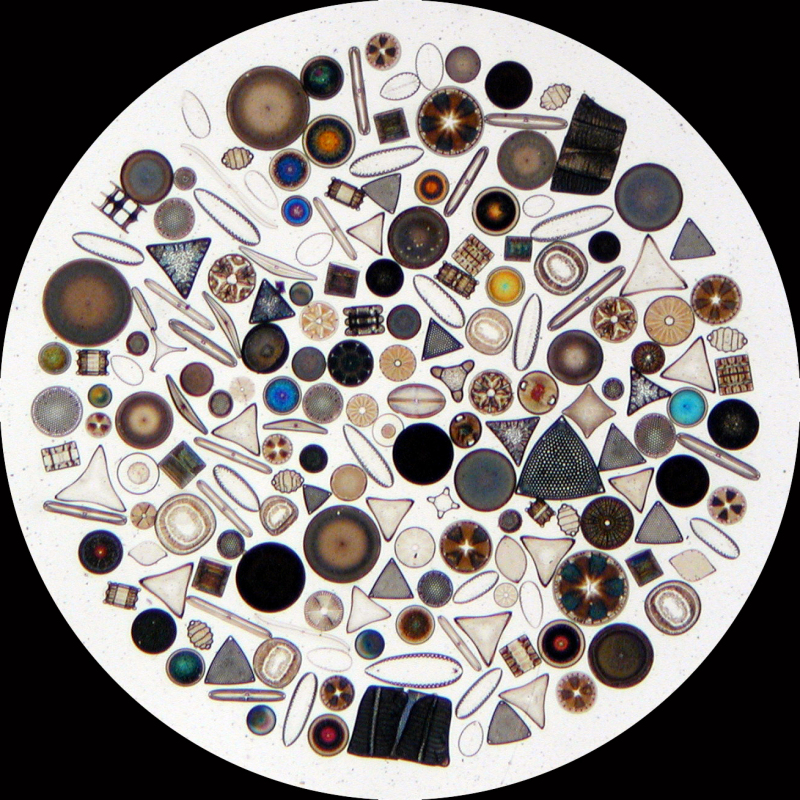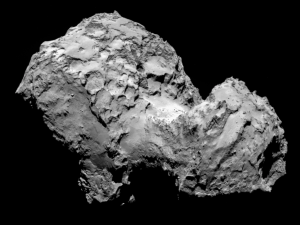Creation Corner
Sea plankton in earth orbit?

The Russian flight director for the International Space Station said this week two cosmonauts had found sea plankton, or traces of them, on the outer hull and window of a Russian module of the International Space Station. If this proves out, they might have proved a key part of the hydroplate theory of the Global Flood without knowing it.
Did the Russians find sea plankton?
The first reports came out early Tuesday morning at ITAR-TASS (Informatsionnoye Telegrafnoye Agyentstvo Rossiy; the TASS is the acronym for the old name Telegrafnoye Agyentstvo Sovietskiy Soyuz). ITAR-TASS published the report in Russian and in their own English translation (not perfect, but accurate enough). Vladimir Solovyev, the “chief of Russian orbital mission,” said two cosmonauts, on a routine spacewalk, were watching the buildup of pollution on the hull and portholes of the two Russian ISS modules, Zarya and Zvezda. Zvezda is the important module. It has the dock for the Soyuz capsules that bring in relief crew. (The new Dragon capsules dock at the Unity module that connects Zarya-Zvezda with the rest of the station.) Zvezda also has the attitude jets that keep the massive space station in orbit. Between the firing of those jets, and the docking operations for Soyuz and Dragon capsules, “space soot” can build up over time.
So two cosmonauts, watching this buildup, took swabs from the hull and one of the two-foot-diameter windows on Zvezda. When scientists on earth examined these, they found traces of sea plankton. (Note: the original Russian uses a word the English version renders as “illuminator.” But that word translates as “window,” both at Google Translate and according to another reader who reads Russian. Given the context, the original author probably had one of the two-foot-wide portholes of Zvezda in mind, not the lens of any “running light.”)
This clearly excited Solovyev. He used an expression that his translators rendered as “absolutely unique.” An English speaker probably would have said, “I’ve never seen anything like it.”
So say the Russians. They haven’t convinced NASA. Spokesman Dan Huot seemed to discount the idea in an interview with Space.com:
The Russians did take samples from one of the windows on the Russian segment, and what they’re actually looking for is residues that can build up on the visually sensitive elements, like windows, as well as just the hull of the ship itself that will build up whenever they do thruster firings for things like re-boosts. That’s what they were taking samples for. I don’t know where all the sea plankton talk is coming from.
How did the sea plankton get up there?
If Solovyev speculated to ITAR-TASS about where those sea plankton came from, ITAR-TASS did not publish it. But The Daily Telegraph (London) did. He noted the sea plankton his scientists found, typically grew on the surface of the ocean and were not native to Baikonur, where all Russian rockets launch from. Then he said,
There are some uplifting air currents which reach the station and settle on its surface.
Walt Brown, of the Center for Scientific Creation, laughed out loud at that idea. The International Space Station generally stays 260 to 265 miles above sea level. This places it in the thermosphere, which lies between two barriers. Winds that could carry any objects from the surface of the sea that high in space are impossible to imagine.
In a discussion with this correspondent, Brown agreed the sea plankton could have gotten onto the hull and outside porthole of Zvezda in only one of three ways:
- Someone somehow contaminated Module Zvezda before the loadmasters even loaded it aboard its Proton rocket.
- Some sea plankton somehow rode one or more launch vehicles, either from Baikonur or Cape Canaveral, aloft.
- The sea plankton were already part of the thermosphere long before NASA and Roscosmos started building the ISS.
Option 1 suggests carelessness of a phenomenal order. For many reasons, scientific and ethical, no one ever sends up a payload without sterilizing it first. Option 2 has two problems. First, those who launched Zarya and Zvezda shrouded them before launch. (If they hadn’t, the tremendous headwinds at Max Q, the highest aerodynamic pressures with which a launching rocket ever has to cope, would have ripped away all their sensitive attachments.) Second, as Solovyev pointed out, Baikonur is too far inland for sea plankton to land on the shroud. Third, even NASA’s Space Shuttle missions couldn’t have carried enough sea plankton to start the kind of colony that could have contaminated Zvezda later.
That leaves Option 3. And Walt Brown can explain that easily.
The hydroplate theory says the Global Flood began when a subcrustal ocean broke containment. This produced a water jet moving at 33 miles per second, fast enough to blow through the atmosphere like a bullet punching a hole in a wall. The seam of this breakout persists as the Mid-Ocean Ridge system. Three of the ridges are in the Pacific basin: the Pacific Antarctic Ridge, the Eastern Pacific Rise, and the Juan de Fuca Ridge. Water breaking out at those parts of the Ridge system could have carried sea plankton aloft.
But can you test that?

Comet 67P/Churyumov-Gerasimenko by Rosetta’s OSIRIS narrow-angle camera on 3 August from a distance of 285 km. The image resolution is 5.3 metres/pixel. Photo: ESA/Rosetta/MPS for OSIRIS Team MPS/UPD/LAM/IAA/SSO/INTA/UPM/DASP/IDA
NASA could test this theory easily, with minimal cooperation from the Russian crew. They could prepare two plates, each made from one of the materials the cosmonauts sampled on their EVA. They would cut each to the largest size that could fit through the airlock. They would then attach a homing beacon to each, sterilize them, and launch them aboard a Dragon capsule. An astronaut would then extract them and remove their shrouds. (He must not touch them, to avoid contaminating the plates with his gloves.) After a few months of station-keeping, another astronaut could take samples, just as the cosmonauts did. Then another Dragon capsule, maybe carrying a robotic or “Waldo”-type capture device, could capture both and bring them down. If analysis of samples taken in space, and of the plates once they reach earth, shows sea plankton, that would confirm what the cosmonauts say they found. (Brown does say the Russians ought to say more about exactly what they found. They gave so little detail, one cannot tell whether they found one-celled diatoms or more sophisticated phytoplankton.)
Brown then suggested a way another space agency could confirm the find sooner. On August 3, the Rosetta spacecraft of the European Space Agency took station next to Comet 67P/Churyumov–Gerasimenko. Rosetta carries another craft that will land on the comet, take a sample, and run mass-spectrography on it. If the Russians did find sea plankton on the hull and windows of Zvezda, says Brown, then Rosetta should almost certainly find sea plankton inside Comet 67P/Churyumov-Gerasimenko.
Reprinted from examiner.com
[subscribe2]
Terry A. Hurlbut has been a student of politics, philosophy, and science for more than 35 years. He is a graduate of Yale College and has served as a physician-level laboratory administrator in a 250-bed community hospital. He also is a serious student of the Bible, is conversant in its two primary original languages, and has followed the creation-science movement closely since 1993.
-

 Civilization5 days ago
Civilization5 days agoTrump’s Venezuela Gamble and America’s Shifting National Security Strategy
-

 Civilization5 days ago
Civilization5 days agoOperation Absolute Resolve: Anatomy of a Modern Decapitation Strike
-

 Civilization4 days ago
Civilization4 days agoTen Reasons To Cheer the Arrest of Maduro
-

 Civilization2 days ago
Civilization2 days agoOne Fell Swoop: Lawsuit Eyes Death Blow to Racial Preferences
-

 Civilization20 hours ago
Civilization20 hours agoTrump’s version of the Monroe Doctrine
-

 Executive20 hours ago
Executive20 hours agoWaste of the Day: Can You Hear Me Now? No.
-

 Civilization1 day ago
Civilization1 day agoTrump’s New Doctrine of Precision Deterrence
-

 Executive3 days ago
Executive3 days agoWaste of the Day: $1.6T in Wasteful Spending in Rand Paul’s “Festivus” Report


















[…] from examiner.com and Conservative News and […]
[…] Sea plankton in earth orbit? […]
Chris Ashcraft liked this on Facebook.
[…] Sea plankton in earth orbit? Go to this article […]
Another great science article from TH! On this line, “There are some uplifting air currents which reach the station and settle on its surface”, one could ask for peer review on this. Is this a common assertion from the space community? Has this claim ever be put in writing? In peer review?
First of all, the press release from ITAR-TASS is too vague to base any judgements on. “Traces of sea plankton” could be anything from diatom fragments to bacterial spores to shrimp poop to who knows what. There is a suggestion that some organisms ‘live’ on the surface of the ISS for years – as spores? multiplying free-living organisms? dormant viruses? We don’t know. “Surveys proved that these organisms can even develop” – where? After retrieval and culturing? In situ on the ISS surface? What does ‘develop’ even mean? We don’t know.
There has been no published scientific report of the findings of the Russian space agency. If there were, it would be subject to criticism. Remember the NASA announcement of arsenic-based life forms back in 2010? Not the agency’s finest hour. Just about every aspect of the arsenic-life paper turned out to be poorly conceived and/or executed. Such may well be the case of the Russian findings – we will only know once the results are formally presented.
Let’s take them at their word, though – let’s assume that some diatoms or cyanobacteria or tardigrades or something were swabbed from the outside of the ISS. While bacterial spores and even diatoms have been collected from as high as 20-40 km in altitude, I would agree that it is unlikely that any viable biological material made it to ~330 km carried by ‘winds’. But let’s look at your hypotheticals:
‘Someone contaminated Zvezda before launch’ – you say that this cannot be, because all payloads are sterilized. But that’s not true. Payloads are assembled in cleanrooms, and great effort is made to minimize contamination, but items going to Earth orbit alone are not routinely sterilized prior to launch. You would be right in thinking that there are sterilization protocols for probe missions that travel to other solar system bodies, so as to avoid the possibility of bringing Earth organisms to, say, Mars. But for LEO missions there’s no need to do that. Even the sterilization procedures performed on interplanetary landers are acknowledged to merely reduce the number of bacterial spores, not eliminate them altogether. Hey- perhaps you have forgotten about link to rt.com
‘Some sea plankton rode one or more launch vehicles’ – you say that even the Space Shuttle couldn’t carry enough plankton to have started the colony that contaminated Zvezda. I have no idea how you would know that, since there is no mention of a ‘colony’ or any mention of the amount or identity, etc., of the ‘plankton’ in question. The whole point of the Russians being outside swabbing windows was to clean up the outside of the ISS, which has become coated with grime from being bathed in years’ worth of rocket exhaust from docking vehicles. I have no idea how you would know that the Shuttle, which sat out on the beach in Florida, sometimes icing up on the launch pad, passing over the Atlantic at launch and then splashing the ISS with RCS exhaust and whatever sublimates off the tiles and windows and whatnot could not have contaminated the ISS externally over what, 26 missions? The other launch sites for ISS resupply are French Guiana, Tanegashima (Japan), and Wallops Island, Virgina – hardly the arid desert of Baikonur.
You ignored or chose not to mention that the ISS exterior could have been contaminated from within, as well. There have been a number of known serious coolant leaks from the ISS, and while those were of ammonia and unlikely to harbor microorganisms, there was also a prolonged air leak of 5 lbs of air a day from an external jumper hose in 2004. There have also been about 175 spacewalks from the ISS to fix these leaks, as well as to perform construction work and routine maintenance. The spacesuits are stored inside the ISS when not in use, and whatever cruft is floating around in the ISS air or on the astronaut’s skin is all over those suits, both inside and out. See: link to twitter.com Now, perhaps the Russian protocols for sample collection from outside the ISS were stringent enough to keep the suit from contaminating the sample containers, but they for sure can’t say that nobody brushed up against those spots on one of the other 100+ spacewalks, or that the window wasn’t washed in leaked atmosphere or what have you.
IF there were microorganisms isolated from the ISS window, my money would be first on contamination from inside the ISS, then contamination from an in-transit spacecraft, then on contamination from the time of assembly or launch of the original components, in that order of likelihood. Lofting from Earth via ‘winds’ would not be on my list of probable causes either.
But let’s look at the possibility that the ‘plankton’ were “already part of the thermosphere” – perhaps co-orbiting with ISS? If so, they’ve been up there for ~4500 years according to Dr. Brown’s hydroplate theory. It would be tough for anything to stay in LEO for that long. But maybe we are constantly plowing through a diffuse cloud of plankton in a circumsolar orbit, or the Moon is perturbing plankton in high Earth orbit and sending them down our way from time to time. Unfortunately they weren’t seen on the collector plates put out on the Mir station in the 1990’s (the Orbital Debris Collector, which was pretty much exactly the experiment that you proposed, except that it’s been done already), or in the Stardust mission which returned material from comet Wild 2 (ditto). Nor did the Genesis mission find any. Oh well.